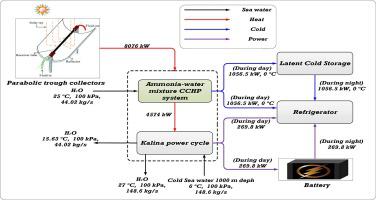Sustainable Energy Technologies and Assessments ( IF 8 ) Pub Date : 2021-06-11 , DOI: 10.1016/j.seta.2021.101329 Bahram Ghorbani , Mehdi Mehrpooya , Majid Sadeqi

|
An integrated structure for cogeneration power and refrigeration using power generation cycles and energy storage systems is proposed and analyzed. The energy storage system is combined with a cogeneration system for cooling and power production driven by a modified Kalina process and renewable solar energy source. The parabolic trough collectors (PTCs) are used to supply inlet heat in the combined cooling, heat, and power plant (CCHP) process. This integrated system produces 1056.5 kW refrigeration at 0 °C temperature and 269.8 kW power during the day for refrigerator and storage systems. Refrigeration and power storage systems are used overnight for the refrigerator. The ammonia-water mixture CCHP cycle and Kalina power unit thermal efficiencies are 68.05% and 8.772%, respectively. The overall irreversibility rate, thermal and exergy efficiencies of the integrated process are obtained 4745.3 kW, 32.85% and 12.25%, respectively. Exergy analysis shows that the HX5 exchanger, phase change material (PCM), and HX1 exchanger have the most amounts of efficiency 0.9981, 0.9976 and 0.9950, respectively. The largest share of exergy destruction belongs to solar collectors (72.63%), heat exchangers (18.39%), and turbines (4.21%). Sensitivity analysis is used to identify important parameters as well as sensitive components of the developed process. This method illustrates the sensitivity in output and important parameters of the modeled cycle against changes in operating conditions.
中文翻译:

一种使用氨水混合冷热电联供循环和储能系统的用于发电和制冷的新型集成结构的热力学和火用评估
提出并分析了使用发电循环和储能系统的热电联产和制冷的集成结构。储能系统与热电联产系统相结合,用于冷却和发电,由改进的 Kalina 工艺和可再生太阳能驱动。抛物线槽式集热器 (PTC) 用于在联合冷热电设备 (CCHP) 过程中提供入口热量。该集成系统在 0 °C 温度下可产生 1056.5 kW 的制冷量,并在白天为冰箱和存储系统提供 269.8 kW 的功率。制冷和电力存储系统通宵用于冰箱。氨水混合CCHP循环和Kalina机组热效率分别为68.05%和8.772%。总不可逆率,集成过程的热效率和火用效率分别为 4745.3 kW、32.85% 和 12.25%。火用分析表明,HX5 交换器、相变材料 (PCM) 和 HX1 交换器的效率最高,分别为 0.9981、0.9976 和 0.9950。火用破坏的最大份额属于太阳能收集器 (72.63%)、热交换器 (18.39%) 和涡轮机 (4.21%)。灵敏度分析用于识别重要参数以及开发过程的敏感组件。该方法说明了模拟循环的输出和重要参数对操作条件变化的敏感性。和 HX1 交换器的效率最高,分别为 0.9981、0.9976 和 0.9950。火用破坏的最大份额属于太阳能收集器 (72.63%)、热交换器 (18.39%) 和涡轮机 (4.21%)。灵敏度分析用于识别重要参数以及开发过程的敏感组件。该方法说明了模拟循环的输出和重要参数对操作条件变化的敏感性。和 HX1 交换器的效率最高,分别为 0.9981、0.9976 和 0.9950。火用破坏的最大份额属于太阳能收集器 (72.63%)、热交换器 (18.39%) 和涡轮机 (4.21%)。灵敏度分析用于识别重要参数以及开发过程的敏感组件。该方法说明了模拟循环的输出和重要参数对操作条件变化的敏感性。



























 京公网安备 11010802027423号
京公网安备 11010802027423号